Class 10 Physics 2019 Solved Past Paper Federal Board
Class 10 Physics 2019
While preparing for any exam, past papers always play a very important role. By studying past papers, a student feels comfortable about his forthcoming exam. We have solved the Class 10 Physics 2019 Past Paper in this post. For more Class 10 Solved Past Paper visit Here.
We are quite hopeful that students of the Federal Board, Lahore Board (BISE Lahore), Rawalpindi Board (BISE Rawalpindi), Multan Board (BISE Multan), Sargodha Board (BISE Sargodha), Faisalabad Board (BISE FSD), Gujranwala Board (BISE GRW), Sahiwal Board (BISE Sahiwal), Bahawalpur Board (BISE BWP) and all the other boards, will get the benefit of this post.
Class 10 Physics 2019 (Local) Paper
Section A
Q1. MCQs
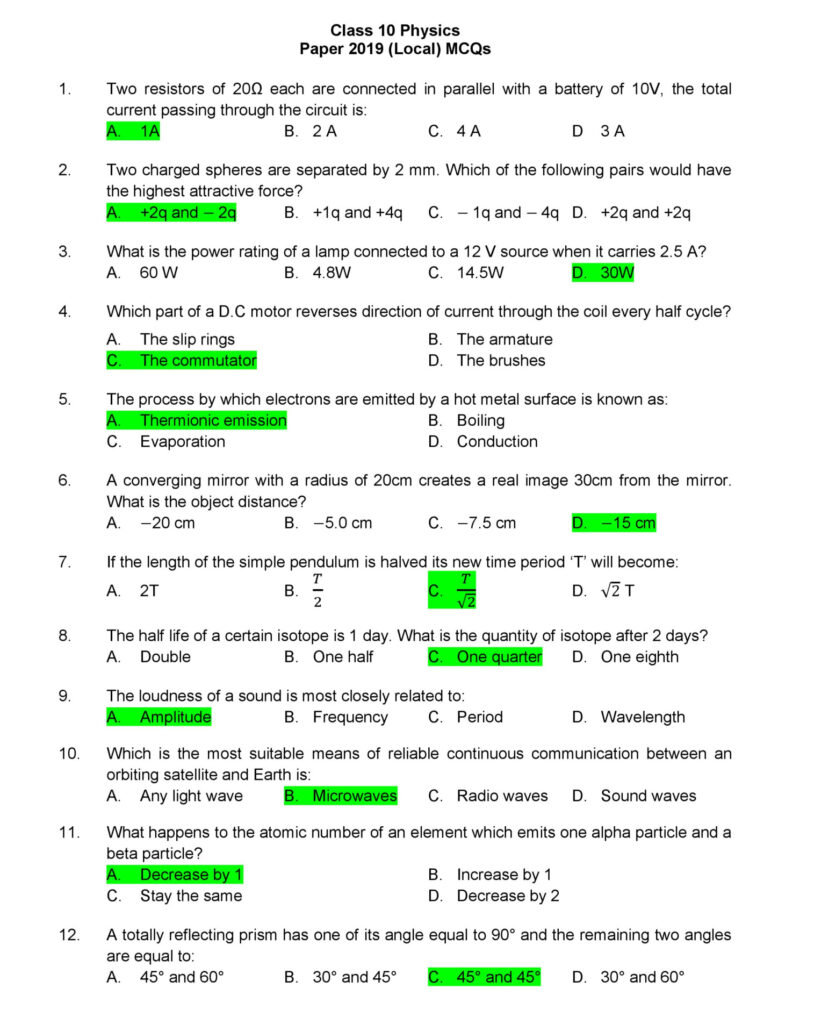
Q2.
(i) Distinguish between longitudinal and transverse waves with suitable examples.

(ii) What is the difference between loudness and intensity of sound? Derive a relationship between these two.

(iii) What is meant by the principle focus of (A) convex lens (B) a concave lens? Illustrate your answer with ray diagrams.

(iv) Show that potential difference can be described as energy transferred per unit charge between the two points.
Ans. Let a charge moves from point A to point B in the electric field, so
P.E of charge ‘q’ at point A = q VA
P.E of charge ‘q’ at point B = q VB
So, Energy transferred = Change in P.E
Energy transferred = P.E at point A – P.E at point B
Energy transferred = q VA – q VB
Energy transferred = q (VA – VB)
Or q (VA – VB) = Energy transferred

(v) Explain the energy dissipation in resistance. What is Joule’s law?
Ans: Energy Dissipation in a Resistance:
When current flows through the conductor, it experiences resistance in the conductor by collisions with atoms of the conductor. The energy supplied by the battery is utilized in overcoming this resistance and is dissipated as heat and other forms of energy.
For example, when a bulb is lit, the energy is taken from the current and is transformed into light and heat energy.
Joule’s Law:
This law states that “the amount of heat generated in a resistance due to flow of charges is equal to the product of the square of current I, resistance R, and the time duration t”. Mathematically,
W = I2 R t
(vi) State and explain the rule by which the direction of the lines of force of the magnetic field around a current-carrying conductor can be determined.
Ans: The required rule is stated below:
“Grasp a wire with your right hand such that your thumb is pointed in the direction of the current. Then curling fingers of your hand will point in the direction of the magnetic field.”
Explanation: The above rule is used to find the direction of the magnetic field around a current-carrying conductor. But we should know the direction of the current in the conductor.
(vii) Write down some benefits of using digital electronics over analogue electronics.
Ans. Digital devices have the following benefits over analog devices:
- Digital devices are more reliable, flexible, and portable as compared to analogue devices.
- Digital signals are easier to transmit and are more secure than analogue signals.
- Digital circuits are less affected by noise.
- Digital systems interface well with computers and are easy to control with software.
- Information storage in digital form is easy.
(viii) Name different information storage devices and describe their uses.
Ans. There are two types of information storage devices:
(a) Primary Memory: It has further two types:
(i) Read-Only Memory (ROM): It starts the computer.
(ii) Random Access Memory (RAM): It is used as a temporary memory for computers.
(b) Secondary Storage Devices: These devices are used to store the data permanently in the computer. They have the following types:
(i) Audio-video Cassettes
(ii) Magnetic Disks
(iii) Hard Disks
(iv) Compact Disc (CDs)
(v) Flash Drive
(ix) Write the Alpha decay process for Pa. Identify the parent and daughter nuclei in this decay.

(x) Find the time period (Te and Tm) of a pendulum of 1 m length, placed on earth and moon.
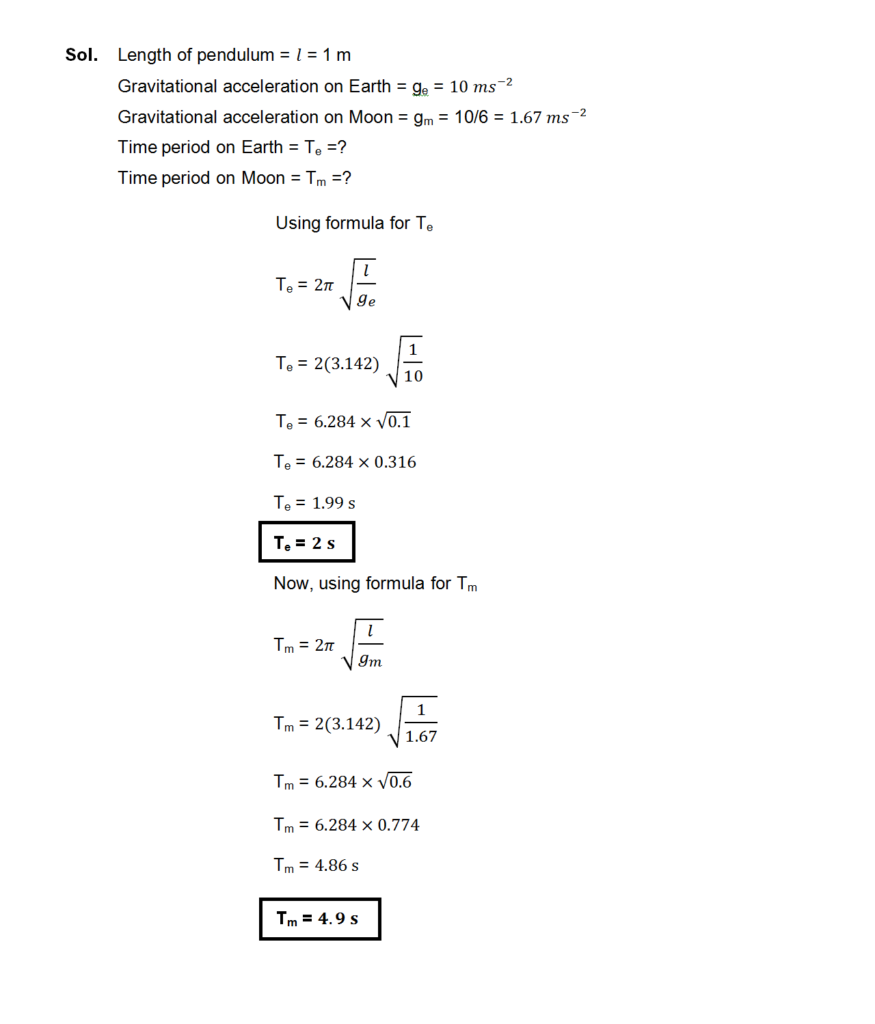
(xi) What are units of loudness? Why do we use a logarithmic scale to describe the range of the sound intensities we hear?
Ans: The unit of loudness is bel, it is a very large unit of the intensity level of a sound. Generally, a smaller unit called decibel is used. Decibel is abbreviated as (dB) and 1 bel is equal to 10 dB.
We use a logarithmic scale to describe the range of the sound intensities because the range is so wide.
(xii) When an object is placed beyond 2F in front of a converging lens, then at what position its image is formed? Whether the image is real and inverted or virtual and erect, magnified or diminished. Draw a ray diagram to show its image formation.
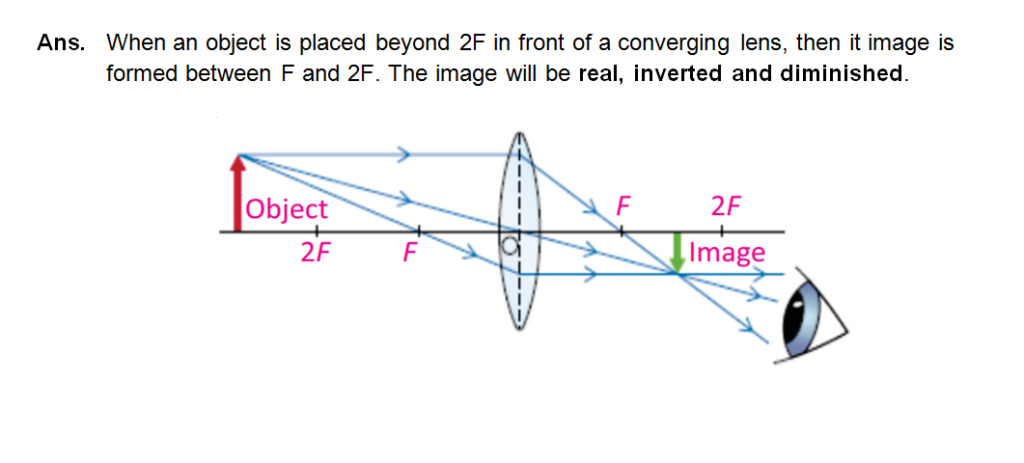
(xiii) An electrified rod attracts pieces of paper. After a while, these pieces fly away. Why?
Ans. Initially, due to electrostatic induction, the pieces of paper get charged and attracted by the electrified rod but after some time the temporarily charged pieces of paper get neutralized due to which these pieces fly away.
(xiv) By applying a potential difference of 10 V across a conductor, a current of 1.5 A passes through it. How much energy would be obtained from the current in 2 minutes?

(xv) Demonstrate by an experiment that a magnetic field is produced around a straight current-carrying conductor.
Ans. Take a straight conductor wire and pass it vertically through cardboard. Now connect the two ends of the conductor wire with the terminals of the battery so that current flows through the circuit in the clockwise direction. The lines of force of the magnetic field produced around the wire would be in the form of concentric circles. If we place a compass needle at different points in the region of the magnetic field, it will align along the direction of the magnetic field. Also if we sprinkle some iron filings on the cardboard around the wire, they will align themselves in concentric circles in the clockwise direction.
Class 10 Physics 2019
Section C
Attempt any Two Questions
Q3. a. Explain defects of vision and their correction both with diagrams. (3+3)
Ans. Defects of Vision: The inability of the eye to see the image of objects clearly is called a defect of vision. There are two main types of defects of vision:
Nearsightedness (myopia)
Some people cannot see distant objects clearly without the aid of spectacles. This defect of vision is known as short sight or nearsightedness and it may be due to the eyeball being too long. Light rays from a distant object are focused in front of the retina and a blurred image is produced.

Correction: The nearsighted eye can be corrected with glass or contact lenses that use diverging lenses. Light rays from distant objects are now diverged by this lens before entering the eye.

Farsightedness (hypermetropia)
The disability of the eye to form distinct images of nearby objects on its retina is known as farsightedness.

Correction: This defect can be corrected with the aid of a suitable converging lens. The lens refracts the light rays and they converge to form an image on the retina.

Q3. b. What do you know about the transmission of light signals through optical fibers? Explain it with a diagram. (3+1)
Ans. OPTICAL FIBRE:
Optical fiber consists of hair size plastic pipe. The inner part of the fiber is called the core which can carry the light energy. The outer concentric shell is called cladding. It is made of plastic with a relatively low refractive index while the core has a relatively high refractive index. The light entering the core strikes the cladding boundary at an angle of incidence greater than the critical angle and is reflected back to the core. In this way, light can travel many kilometers with a small loss of energy.
The optical fibers work on the principle of total internal reflection.

Q4. a. Explain the combination of capacitors in series and in parallel with diagrams. Also, find an expression for their equivalent capacitance. (3+3)
Ans. Capacitors in Series:
In this combination, the capacitors are connected side by side i.e., the right plate of one capacitor is connected to the left plate of the next capacitor.

Expression for Equivalent Capacitance:
The voltage of the battery has been divided among the various capacitors. Hence

Capacitors in Parallel:
In this combination, the left plate of each capacitor is connected to the positive terminal of the battery by a conducting wire. In the same way, the right plate of each capacitor is connected to the negative terminal of the battery.
Expression for Equivalent Capacitance:
The voltage of the battery has been divided among the various capacitors. Hence

Q = Q1 + Q2 + Q3
Q = C1 V +C2 V + C3 V
Q = V (C1+C2+C3)
Ce V = V (C1+C2+C3)
Thus Ce = C1+C2+C3
Q4. b. A mass of 50 g is attached to one end of a spring of spring constant 10 Nm-1, whose other end is tied with a wall. Find the period and frequency of its oscillations. (2+2)
Sol. Mass = m = 50g = 50/1000 = 0.05 kg
Spring constant = k = 10 Nm-1
Time period = T =?
Frequency = f =? Using formula
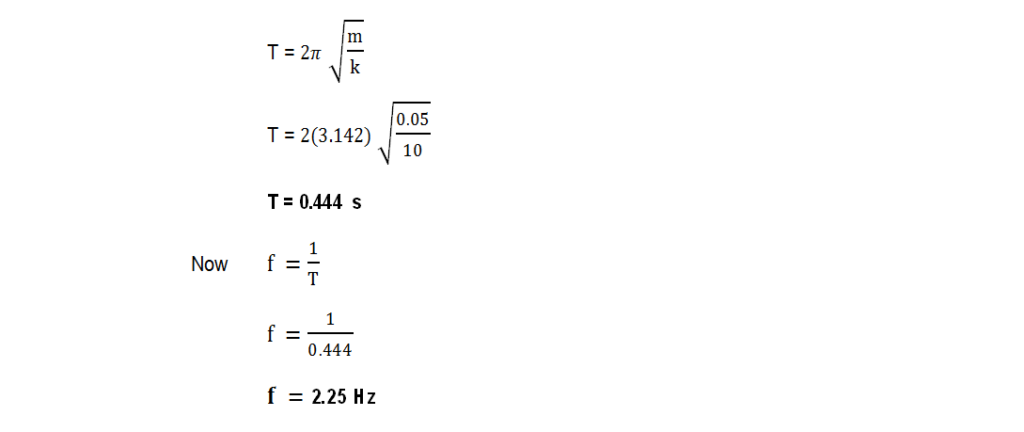
Q5. a. Explain the Half-life of a radioactive element with a graph and decay equation. Also, clarify the terms parent element and daughter element. (6)
Ans. Half-life: The time during which half of the unstable radioactive nuclei disintegrate is called the half-life of the sample of radioactive elements.
Example: Every radioactive element has its own characteristic half-life. For example, radium-226 has a half-life of 1620 years, which means that half of a radium-226 sample will be converted to other elements by the end of 1620 years. In the next 1620 years, half of the remaining radium will decay, leaving only one-fourth of the original amount of radium, and so on.

Explanation: If the half-life of the radioactive element is T1 ⁄ 2 , then at the end of this time the number of atoms in the sample will become half i.e., 1/2. After a time 2T1 / 2 , i.e., after second half-life period, the number of remaining atoms will become 1 ⁄ 2 . 1 ⁄ 2 = 1 ⁄ 22 = 1 / 4, after a time 3 T1 ⁄ 2, the number of remaining atoms left will be 1 ⁄ 2 . 1 ⁄ 2 . 1 ⁄ 2 =
1 ⁄ 23 = 1 / 8 and at the end of ‘t’ half-lives number of atoms that remain will be. It means that if No is the original number of atoms in the sample of the radioactive element, then after ‘t’ half-lives number of atoms left in the sample can be determined by using the relation,
Remaining atoms = Original atoms x 1 / 2t
or N = No x 1 / 2t
Parent Element: The unstable radioactive element that disintegrates is called a parent element.
Daughter Element: The stable element obtained as a result of the disintegration of a parent element is called a daughter element
Q5. b. What do you know about the NAND gate and NOR gate? Draw their circuit diagrams, symbols, and truth tables. Give a Boolean equation for each. (2+2)
Ans. NAND Gate: The combination of AND gate with NOT gate (at the output) is called NAND gate. In NAND gate the output of AND gate is inverted. The bubble in the symbol of NAND gate shows that the output of AND gate is inverted.

NOR Gate: The combination of OR gate with NOT gate (at the output) is called NOR gate. In NOR gate the output of OR gate is inverted. The bubble in the symbol of NOR gate shows that the output of OR gate is inverted.


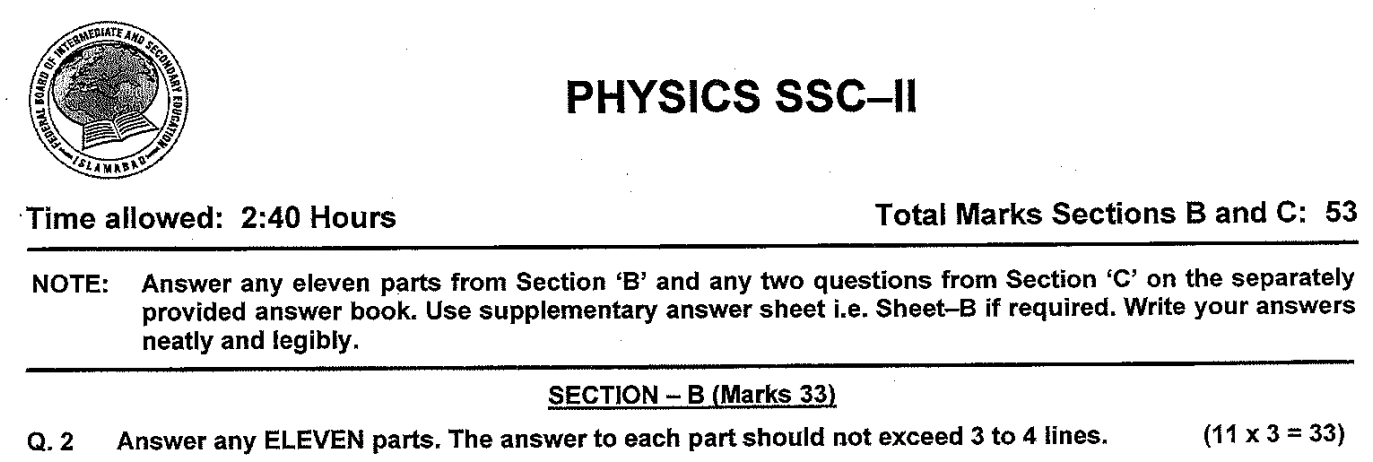



Very good